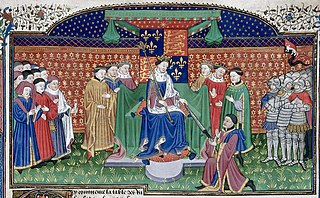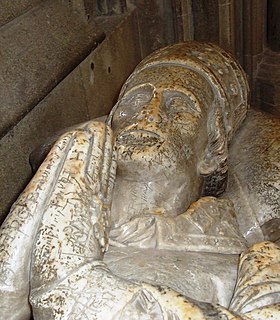Related Research Articles

Robert Hallam was an English churchman, Bishop of Salisbury and English representative at the Council of Constance. He was Chancellor of the University of Oxford from 1403 to 1405.

John Stafford was a medieval English prelate and statesman who served as Lord Chancellor (1432–1450) and as Archbishop of Canterbury (1443–1452).
Silvester de Everdon was a medieval Bishop of Carlisle and Lord Chancellor of England.
Marmaduke Lumley was an English priest, Bishop of Carlisle from 1429 to 1450, and Knight Commander of the Order of St. John of Jerusalem. He was a son of Ralph de Lumley, 1st Baron Lumley and Eleanor de Neville. He was elected about 5 December 1429, and consecrated on 16 April 1430. He was Bishop of Lincoln for a short time before his death in December 1450. He was educated at University of Cambridge and was appointed Precentor of Lincoln Cathedral in 1425. He also became Chancellor of the University of Cambridge in 1427 and was Master of Trinity Hall, Cambridge from 1429 to 1443. From 1446 to 1449 he served as Lord High Treasurer of England. Lumley's tenure as Lord High Treasurer occurred during the Great Bullion Famine and the Great Slump in England.

Edward Story was an English priest, Bishop of Carlisle, 1468–1477, and Bishop of Chichester, 1477–1503.
William Senhouse, also called William Sever, was an English priest, successively Bishop of Carlisle, 1495–1502, and Bishop of Durham, 1502–1505.

George Neville was Archbishop of York from 1465 until 1476 and Chancellor of England from 1460 until 1467 and again from 1470 until 1471.
Richard Courtenay was an English prelate and university chancellor, who served as Bishop of Norwich 1413-15.
Thomas Brunce was a 15th-century Bishop of Rochester and then Bishop of Norwich.

Robert de Stratford was an English bishop and was one of Edward III's principal ministers.

Ralph of Shrewsbury was an English medieval bishop and university chancellor.
William Percy was a late medieval Bishop of Carlisle. He was the fifth son of Henry Percy, 2nd Earl of Northumberland, and his wife Lady Eleanor Neville. Percy was in 1451 appointed to be Chancellor of the University of Cambridge, a post he held until 1456. He was selected 30 August 1452 to be Bishop of Carlisle following the appointment of his predecessor Nicholas Close to the Bishopric of Coventry and Lichfield. Percy was consecrated between 16 November and 18 December 1452. He died on 26 April 1462.
Richard Praty was a medieval university Chancellor and Bishop.
Lewis de Charleton was a medieval Bishop of Hereford in England.
John Gilbert was a medieval Bishop of Bangor, Bishop of Hereford and Bishop of St. David's.

John Stanberry was a medieval Bishop of Bangor and Bishop of Hereford.
Richard Young was a medieval Bishop of Bangor and Bishop of Rochester.

Richard FitzJames was a medieval Bishop of Rochester, Bishop of Chichester and Bishop of London.

Simon of Ghent was a medieval Bishop of Salisbury in England.

Roger Martival was a medieval Bishop of Salisbury in England.
References
- Fryde, E. B.; Greenway, D. E.; Porter, S.; Roy, I. (1996). Handbook of British Chronology (Third revised ed.). Cambridge, UK: Cambridge University Press. ISBN 0-521-56350-X.
- Hibbert, Christopher, ed. (1988). "Appendix 5: Chancellors of the University". The Encyclopaedia of Oxford . Macmillan. pp. 521–522. ISBN 0-333-39917-X.